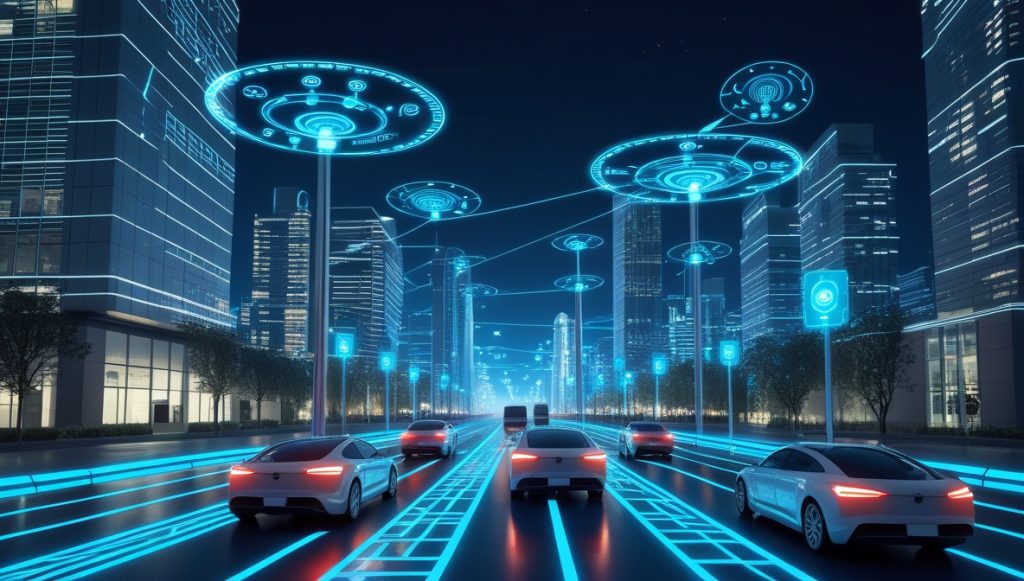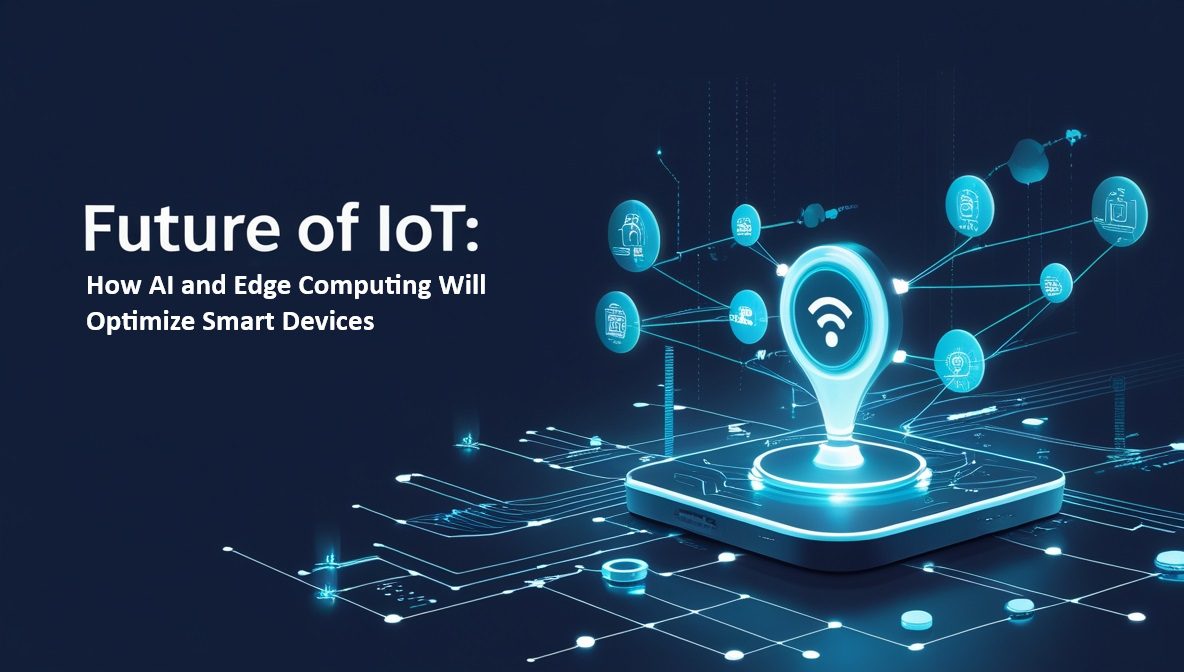The future of IoT is evolving rapidly with the integration of Artificial Intelligence (AI) and Edge Computing, transforming smart devices into more responsive, efficient, and intelligent systems. The technological evolution reveals that AI and IoT working with edge computing will transform several industries and their processes as they make user experiences better. The IoT enhances devices through real-time operational efficiency so they can perform autonomous actions independently of human supervision. This article explores how AI and edge computing will shape the future of IoT, creating smarter and more autonomous devices.
AI’s Role in the Future of IoT

The reshaping of IoT through artificial intelligence occurs as a result of its capability to automate systems and perform predictive analytics and real-time decision functions. Traditional IoT systems existed merely to gather and send data until they received AI integration which granted them abilities to analyze patterns and detect anomalies and make decisions autonomously. Real-time data analysis through AI-powered IoT sensors makes smart cities operate through traffic flow management and building energy optimization and waste management enhancements.
Healthcare wearable IoT technology enables the detection of upcoming health risks by assessing patient vital signs to notify medical staff before health emergencies unfold. Through its application of AI industrial IoT (IIoT) tracks machinery conditions to foresee equipment breakdowns and improves manufacturing processes while decreasing both equipment stoppages and business expenses. The future development of AI technology will promote IoT devices to gain self-learning capability and adaptability which drives enhancement of productivity throughout various industries.
AI-Driven Automation and Decision-Making
The processing capabilities of IoT devices become autonomous because of AI which decreases human involvement. Machine learning algorithms integrated with smart devices allow them to recognize patterns for real-time outcome forecasting and decision-making capabilities. The automated processes generate increased efficiency rates and lower operational costs for healthcare and manufacturing businesses as well as smart city installations.
Predictive Maintenance and Performance Optimization
IoT devices equipped with artificial intelligence capabilities analyze sensors to determine when equipment systems will fail before actual failure occurs. The use of predictive maintenance methods in manufacturing and logistics operations enables companies to decrease equipment downtimes and improve their machinery’s operational lifetime. Through early identification businesses can optimize their resources together with lowering their maintenance expenses.
Enhanced Security and Threat Detection
AI provides IoT security enhancements through its capability to find irregularities in network activities against growing digital threats. Operational threat detection systems powered by AI analyze network activities to uncover security risks before they affect connected devices thus securing them from cyberattack threats. Security demands in important sectors including finance and healthcare as well as critical infrastructure require this system which ensures top-level data protection.
Edge Computing’s Impact on Smart Devices

IoT applications gain significant benefits from Edge computing because it brings data processing power closer to its source points rather than keeping it locked inside distant cloud servers. The processing at the edge point decreases latency while boosting performance which results in rapid decisions when working in real time. Self-driving vehicles depend on edge computing to analyze sensor data instantaneously which lets them execute driving commands independently from cloud-based commands.
The analysis of machine performance through edge-enabled IoT devices in smart factories occurs locally which helps prevent system failures from happening before they occur. Edge computing systems that power security platforms develop threat identification capabilities in real time thus ensuring better reliability and privacy because they function independently of continuous cloud communications. The efficiency alongside scalability and security of IoT systems becomes enhanced through edge computing because it decreases bandwidth consumption together with response time.
Reduced Latency for Real-Time Processing
Smart devices that process data at their local locations can generate immediate responses to their inputs. Autonomous vehicles as well as industrial automation and healthcare monitoring applications need split-second decisions which require this capability. Edge computing makes cloud-based processing delays tolerable through its approach which results in smooth and dependable execution.
Bandwidth Optimization and Cost Efficiency
The distribution of processing tasks at localized points cuts down the amount of data that needs to transfer to remote cloud servers. Through local data processing organizations reduce their bandwidth requirements and their associated cloud storage expenses. Systems that process data at its source deliver valuable benefits especially for large IoT networks in cities and industries which deal with substantial data output.
Improved Data Privacy and Security
Data processing near the source of information creates enhanced security because it reduces potential attack exposure. Using edge computing technology enables security standards that keep sensitive healthcare and financial data within legally restricted operational areas. The combination helps organizations obey data privacy laws and minimizes the chance of security breaches.
The Future of IoT: AI and Edge Computing Integration

The integration of AI and edge computing is shaping the future of IoT, making devices smarter, more efficient, and highly responsive to user needs. Heritable devices with AI capabilities now handle local data processing because of which they improve immediate decision-making capabilities. These advancements will establish independent IoT ecosystems that need almost no human oversight for operation. The future of IoT technology will bring about automated networks where devices network together to maximize operational efficiency while decreasing expenses and improving value delivery.
From automated supply chains and AI-driven healthcare monitoring to smart homes that adapt to user preferences, the future of IoT is moving toward a more interconnected, data-driven, and intelligent world. Companies which adapt to this transformation will acquire a strategic advantage through their implementation of quicker better reliable and flexible IoT solutions for future use.
Autonomous and Self-Learning IoT Systems
The future of IoT lies in devices that can learn and adapt over time. AI-driven IoT systems will become more self-operating through an improved capacity to optimize performance with no human involvement. Smart homes together with industrial automation and healthcare technologies will experience advancements as a result.
AI-Powered Personalization and User Experience
Smart devices will implement personalization through AI systems to became more user-focused. Intelligent devices including wearables and car systems alongside smart home assistants will use continuous user behavior tracking to create personal experiences that enhance everyday life convenience.
Scalable and Sustainable IoT Ecosystems
The expansion of IoT technology becomes achievable through AI and edge computing solutions which provide sustainable performance. Business operations and governmental institutions plan to establish energy-saving smart grids and intelligent transportation systems together with sustainable industrial automation solutions. Reduced energy consumption combined with sustainable practices will develop as the main outcome of these efforts.
Conclusion
The Future of IoT is set to be more intelligent, efficient, and secure with the integration of AI and edge computing. Real-time decision-making and enhanced security functions together with performance optimization capabilities through these technologies serve various industries. Businesses alongside developers must welcome AI and edge computing systems to lead successfully within this transformative period thus enabling IoT to modify how we connect with technology.

